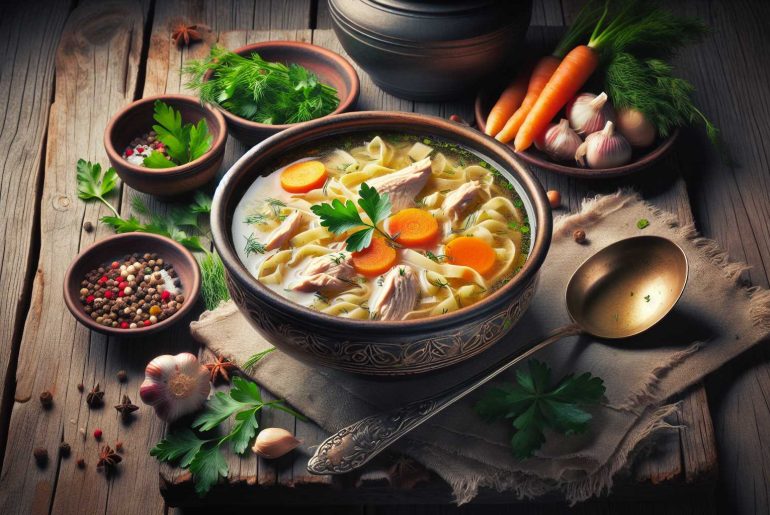
Rosol is a classic chicken noodle soup from Poland, loved for its simple yet rich flavor. This dish is a big part of Polish culture, often enjoyed during the winter and at family events.
Making Rosol is both an art and a science, as it requires a careful selection of ingredients to get the taste just right. We’ll take a closer look at how Rosol came to be, what goes into it, and how it’s made.
Plus, we’ll talk about why it’s so popular, not just for its taste but for its comforting qualities and health benefits too.
The Origins of Rosol
Rosół is more than just a soup in Poland; it’s a rich part of the country’s culinary history that dates back to the medieval times. This dish is a perfect example of how Polish cuisine has evolved over centuries, adapting to various influences yet maintaining its unique character. Originally, Rosół was a luxury, combining local ingredients with cooking methods brought by Italian and French chefs who were popular among the Polish nobility. This blend of influences highlights the openness of Polish cuisine to external ideas while keeping its essence.
As time went by, Rosół transformed. It went from being a fancy meal for the elite to a beloved comfort food found in nearly every Polish home. This change tells us a lot about the shifts in society and economy in Poland. Families across the country now gather around tables to enjoy this warm, nourishing soup, which strengthens family ties and keeps traditions alive. It’s fascinating to see how a simple dish can play such a significant role in the culture.
To understand Rosół’s importance is to look into the heart of Polish culinary practices. For instance, preparing Rosół on Sundays is a widespread tradition. It’s not just about making soup; it’s a ritual that brings families together, offering a moment of warmth and connection in their busy lives. This tradition also shows the adaptability of Rosół, as each generation adds its twist to the recipe, making it a living symbol of Polish heritage.
Essential Ingredients
To really get why Rosół is such a big deal in Polish culture, let’s dive into what goes into making this cherished dish. The heart of Rosół is its broth, and getting it right is all about choosing the right chicken parts. You might use a whole chicken or just parts like wings, thighs, or even the carcass to get a rich flavor. Then, there are the root veggies – carrots, parsnips, celery root, and leeks – which are key for adding those aromatic notes everyone loves.
Don’t overlook the onion, which is often thrown in with its skin on to give the broth a beautiful golden color and add an extra layer of taste. The spice mix is what really sets Rosół apart. A bundle of bay leaves, allspice, and black peppercorns is simmered in the soup, creating a flavor that’s both unique and comforting.
When you put all these ingredients together, you get more than just a soup; you get a taste of Polish tradition. Each component, from the chicken to the spices, works together to create something special. It’s a perfect example of how simple ingredients, when chosen carefully and cooked with intention, can create a dish that’s much more than the sum of its parts. Whether you’re trying to impress guests or just making a cozy meal for the family, Rosół is a go-to recipe that never disappoints. Plus, it’s a great way to show off the rich culinary heritage of Poland in a single bowl.
Step-by-Step Preparation
Making Poland’s traditional chicken noodle soup, Rosół, starts with careful preparation. First off, choose a whole chicken and clean it well. This chicken is then placed in cold water to begin creating the broth. Next, add root vegetables like carrots, parsnips, and celery roots to the pot. You might also want to throw in some onions and maybe leeks for extra flavor. These ingredients are then cooked on a low heat. This slow cooking allows the flavors to blend together and the broth to become clear over time.
An important part of making Rosół is removing the impurities that float to the top of the broth. This skimming process is crucial for achieving the soup’s signature clear, golden broth. It’s a step that requires patience but is key to getting that rich flavor and clarity Rosół is known for.
When choosing ingredients for Rosół, go for quality. A free-range or organic chicken will give the broth a richer flavor. For vegetables, fresh, organic options are best. They not only contribute to the taste but also ensure you’re getting a healthier meal.
Serving Traditions
In Poland, serving Rosół, a traditional chicken soup, is more than just about the food; it’s a reflection of the country’s culture and social values. This soup usually comes as a clear broth filled with noodles, chicken pieces, and sometimes vegetables. It’s a warm welcome to guests, symbolizing hospitality and family connections. Often served as the opening dish during important meals like Sunday family gatherings and holidays, Rosół sets the mood for the event.
This practice of serving Rosół goes beyond just offering a meal; it’s a sign of respect for the country’s culinary heritage and the importance of eating together. Making and presenting the soup carefully shows the value placed on food traditions and the communal dining experience in Poland. Rosół acts as a key element in bringing people together, emphasizing its role in Polish culture and social interactions.
Health Benefits
Poland’s traditional soup, Rosół, is much more than a cultural icon. It’s packed with health benefits that make it a powerhouse meal. At its core, Rosół is a simple dish made with chicken, vegetables like carrots, onions, and parsley, and often noodles. This combination delivers a meal that’s not only delicious but also full of nutritional value.
First off, the chicken in Rosół makes it a great source of protein, which is crucial for muscle repair and growth. When you eat this soup, you’re helping your body build and repair tissues. Moreover, as the soup simmers for hours, it pulls collagen from the chicken bones. This is great news for your joints and skin, as collagen plays a key role in keeping them healthy and elastic.
But it’s not just about the chicken. The vegetables in Rosół bring their own set of benefits. They’re rich in vitamins, minerals, and antioxidants. These nutrients boost your immune system and fight inflammation, helping you ward off illnesses and feel your best. It’s like getting a natural health boost with every spoonful.
Rosół is also known for its healing properties, especially when it comes to colds and flu. This isn’t just folklore. The hot broth can help clear congestion, and the nutrients support your body’s healing process. It’s a go-to remedy in many Polish households for a reason.
In essence, Rosół is a testament to the idea that food can be both nourishing and healing. It’s a dish that brings together the best of taste and health benefits, making it a beloved staple in Polish cuisine for good reason. Whether you’re looking for a comforting meal or a natural way to boost your health, Rosół is worth trying.
Conclusion
Rosół, the classic Polish chicken noodle soup, is a big deal in Poland. It comes from a long history and is made with carefully chosen ingredients and traditional methods.
This soup is more than just food; it’s a way of bringing people together and is thought to be good for your health too. It shows how food, culture, and health are all connected.
This beloved dish has been passed down through generations and continues to be a favorite in many Polish households.







Comments are closed.